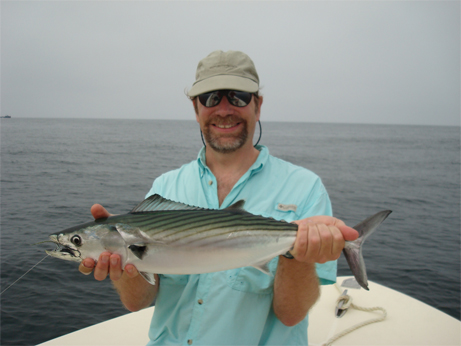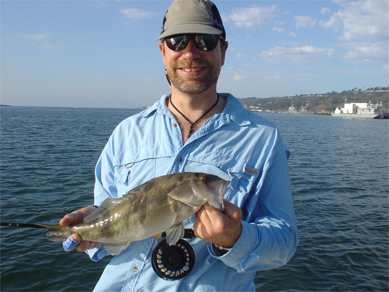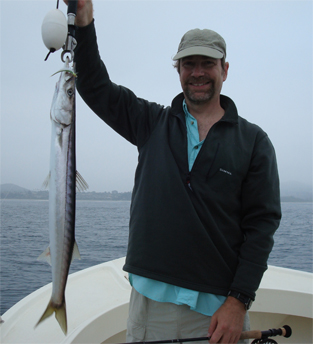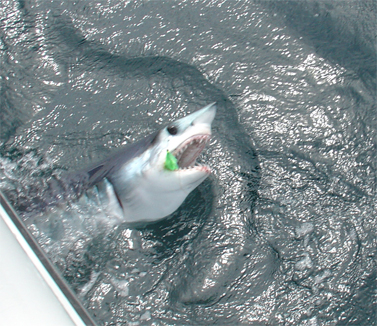SoCal Fly Fishing

Bonita taken off San Diego coast
Southern California does not immediately come to mind as a fly fishing destination in the way that, say Florida, does. Yet, the San Diego and Orange County areas actually have an abundance of saltwater fly fishing that experiences very little pressure.
SoCal Saltwater Fisheries
SoCal fishing can be divided up into four basic fisheries:
- Beaches - fishing the breakers for surfperch, corbina, and halibut
- Bays - fishing the bays for bass, croaker, bonita, and maybe even bonefish
- Near-shore - fishing kelp beds and rocks for bass, barracuda, bonita
- Off-shore - fishing out for big sharks, sailfish, and tuna
Beaches

The beaches are one of my favorite places to fish in California. You can do it on your own with little gear and, with a little practice, can catch fish almost any morning. The beach fishery is usually an early morning event, hitting the water at daybreak and fishing until around 9 a.m. when swimmers start showing up in numbers. The primary fish are surfperch and corbina with corbina being the permit of California surf. This is a tough fish to figure out but once you do they are catchable and, in fact, I've now landed more corbina than permit in a few weeks of fishing. You can also catch halibut and sand sharks or shovel-nosed guitarfish from the beach. The primary food source for beach fish is the Pacific Mole crab, a small gray-ish crustracean that happens to carry a bright orange roe sack so the most productive flies almost always have some orange on them. Secondary food sources include shrimp and baitfish.
Below are some of my favorite beach patterns:
-
 Surfin Merkin
Surfin Merkin -
 Calhoun's Swimming Sand Crab
Calhoun's Swimming Sand Crab -
 Piconi's Prowler
Piconi's Prowler -
 Bob's Shrimp
Bob's Shrimp
Flies are fished with a short 3' leader and a 200 or 300-grain shooting head line. I use a 6-weight rod almost exclusively in the surf and it loads well with the 300-grain head. Needless to say, in the surf a stripping basket is essential as is a surf-jacket to keep from getting soaked. The Simms surf-jacket that was discontinued is great though most any kayaking jacket will work. A really good guide to getting started can be found at Corbina on the Fly by Richard Jacobsen.
Bays

The bays in San Diego are home to several species of sand bass, croakers, bonita, and recently bonefish. Bays are best fished from a boat, a kayak, or even a stand-up paddleboard. Gear is similar to beach fishing, a 9' 6-weight rod is ideal paired with a 200 or 300-grain head. This is not flats fishing by any means but fishing deeper grass flats and drop-offs where the fish hang and you need to get down to them. I carry several spools and often switch between the heavier and lighter lines. The biggest trick is finding the depth of the fish and "counting down" the fly to that depth. The retrieve really is a jigging technique and the fish often take on the drop very lightly.
Fly selection is also different than beach fishing since the primary bait is baitfish. A Clouser is hard to beat and I carry them in several colors. I also use my near-shore flies some in the bays, these are epoxy head streamers.
-
 Clouser
Clouser -
 Mackerel/Herring
Mackerel/Herring -
 Sardina
Sardina
Near-shore

Kelp beds rule the near-shore fishery in California and are home to the Kelp Slam - Bass, Barracuda, and Bonita. Again this fishery is accessible by boat, kayak or stand-up paddle board. This fishery is often done by chumming up fish either tossing live bait out or sticking a chum bucket in the water and waiting for bait then bigger fish to appear out of the kelp. The action usually starts with Pacific Mackerel then proceeds to barracuda, bass, and bonita as the bite increases.
Gear is similar to bay fishing but maybe beefier. I usually carry a 6- or 7-weight but also an 8-weight rod which can help horse bigger fish out of the kelp. Like the bays a 200-400 grain head is the best line. Flies are the same as bay fishing but can get a bit larger in size out in the open water.
Off-shore

The offshore is home to sharks - Makos, Blues, and the occasional Great White. It can also be home to Pacific Marlin, Mahi-Mahi (Dorado), and several species of tuna. I've done the shark thing several times and have caught makos and blues up to 125 lbs on a 14-weight rod. This is not your typical trout fishing experience, you motor 5-15 miles offshore, set up a chum slick and wait for big fins to appear. Then it is a bait and switch operation to get the shark hot on the bait near the boat, you cast your 12" fly to the side of the shark as the bait is pulled up and hang on. Makos jump and then sound and are really tough to get in to the boat. Then there is releasing them while their head is shaking and the razor sharp teeth are cutting through the air. This is about as exciting as it gets and the only thing I've had close are encounters with huge tarpon and a tarpon probably won't take your arm off if you get too close. There is nothing quite like it.
This is big gear country. A 10-weight is good for small blues which often come in first but when the big fins appear grab the 12 or 14-weight. Wire is essential, for small fish tiger wire will do the trick but the big boys need real wire.
Shops, Guides, and Resources
Shops
- SoCal Fly Fishing - new shop in San Diego owned by Peter Piconi. Great resource for all fly fishing in SoCal with a guide service offering all types of fishing.
- San Diego Fly Shop - in Solana Beach, also a good shop.
Guides
- Peter Piconi of Fly Fish San Diego - I've been going out with Peter since I started going to San Diego to fish. Good beach, bay, and nearshore trips.
- On the Fly with Capt. Dave Trimble - I've gone sharkin with Dave several times and always have a blast.
- Bowman Bluewater with Conway Bowman - Conway pretty much invented shark fly fishing in SoCal.
- Pacific Coast Fly Fishing with Bryan Webb - serving Orange and LA counties, Bryan is always fun to go out to the kelp beds with.
Resources
- Beyond the Breakwater - great websource for California near-shore fishing
- Gary Bulla's Saltwater Fly Fishing - another good SoCal resource, extending to Baja
SoCal Trips
- SoCal 2010 - Fishing kelp, bays, harbors, and beaches.
- Jaws II - SoCal Fly Fishing Sept 2008 - Fly fishing for Sharks, the Kelp Grand Slam, and Surfperch - Bad weather (again) but we never got skunked
- San Diego Slam June 2006 - Makos offshore, Corbina on the Beach, and Bass in the Bay